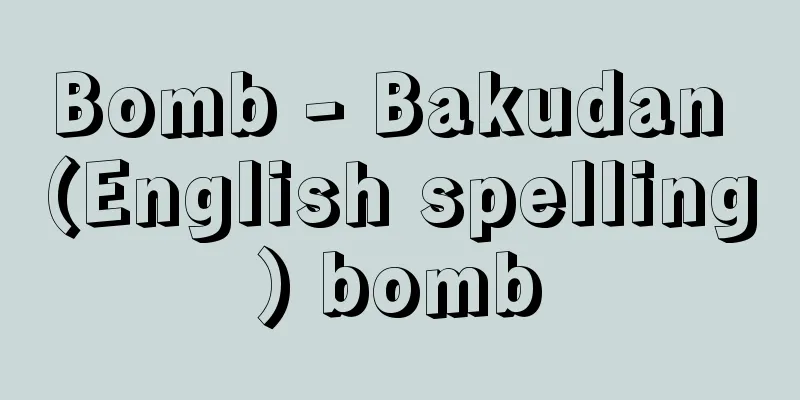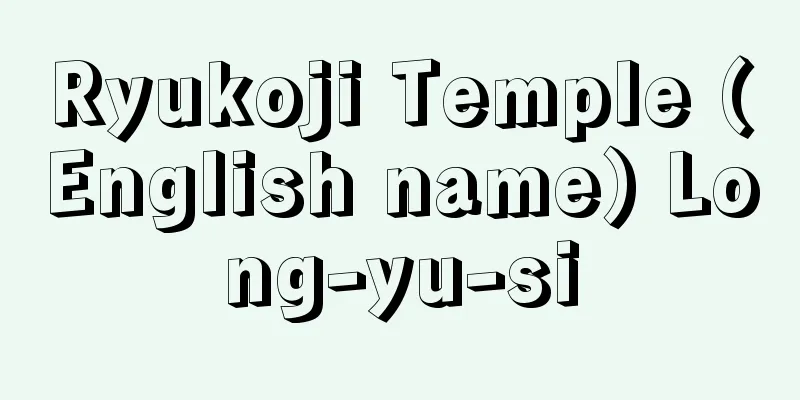Bomb - Bakudan (English spelling) bomb

|
Generally speaking, it refers to explosives for killing or destruction, or thrown explosives such as grenades, but today it mainly refers to free-fall bombs dropped from aircraft. In contrast to free-fall bombs, bombs with propulsive power, such as guided missiles and rockets launched from aircraft, are called stand-off weapons. In the early days of World War I, artillery shells with stabilizing tails were used as bombs for aircraft, but later, streamlined projectiles with four cross-shaped wings were used, and in World War II, various types and applications such as braking bombs and parent-child bombs were used, and finally the nuclear bomb with its enormous power appeared. There are various types of bombs for land use, anti-ship use, anti-submarine use, and special use, and each type is classified as nuclear or non-nuclear, guided or unguided. For land use, there are bombs for killing people and for destroying solid structures. For land use, there are bombs for killing people and for destroying solid structures. For personal use, the explosive charge is relatively large, and in order to scatter fragments, an instantaneous fuse is used, or a proximity fuse is used to explode at an appropriate height above the ground, and sometimes a parachute is attached. CBU (ball bomb, etc.), which is a bundle of many small bombs, is also used. For destroying structures, bombs with semi-delayed fuses with high penetration power are used, and there are also bombs with braking tails for vertical penetration, scattered penetrators for destroying runways, and land mines. For anti-ship use, there are normal bombs and armor-piercing bombs, the former with semi-delayed fuses to destroy light armor, and the latter with slow-delayed fuses, thick shells with relatively small explosive charge, and designed to penetrate heavy armor and cause fatal damage. Anti-submarine bombs have hydraulic fuses and explode at a set depth. Some rockets fired at surfaced submarines have no explosives and are designed only for penetration. Special bombs include incendiary, poison gas, biological, smoke, illumination, and time bombs. Incendiary bombs are mainly used to attack cities and supply dumps, but napalm, a type of oil-based incendiary bomb, is also used to kill personnel on the battlefield. Fuel-air explosive (FAE) bombs scatter fuel in the air and ignite it, creating a tremendous pressure to destroy buildings and suppress personnel over a wide area. Guided bombs have a guidance sensor and control wings at the tip and a stabilizing fin at the tail, allowing them to change the trajectory and achieve higher accuracy. Guidance methods include television, laser, and infrared. Television guidance records the image from a television camera at the tip and then moves towards that image. Laser guidance uses a laser to illuminate the target from the bomb-dropping aircraft or other equipment, and the reflected wave is guided towards the target. This means that the target must be illuminated with the laser until it hits. Infrared guidance uses a sensor to compare the temperature difference between the target and the surrounding area, and the bomb will usually fall towards the area with a higher temperature. In recent years, the accuracy of guidance systems has increased, resulting in an extremely high hit rate, and these bombs are also known as precision-guided bombs. The size of the bomb ranges from a few kilograms to several tons depending on the purpose. Four types of bombs are usually used for land and anti-ship use: 225 kg, 340 kg, 450 kg, and 910 kg. CBUs, napalm bombs, etc. also come in different sizes. Guided bombs are usually bombs or armor-piercing shells with a guidance device added, and there are various types of them. TNT is generally used as the explosive, and fragmentation shells account for 60% of the total weight, and armor-piercing shells account for about 20%. Nuclear bombs have an explosive force of several kilotons to several hundred kilotons of TNT due to the fission of nuclear materials such as plutonium. Furthermore, hydrogen bombs, which use the high temperature generated by fission shells as a trigger to cause thermonuclear fusion, can reach an explosive force of tens of megatons. Nuclear bombs, which have a large explosive power, are powerful when used for strategic attacks, but the range of destruction and damage they cause is too large for tactical attacks, making them difficult to use, so efforts are being made to limit their explosive power and make them smaller. The goal is to be able to use them in the same way as non-nuclear bombs and achieve the effect of destruction and control with one shot. [Kenichi Aoki] [Reference] | |©Shogakukan "> Bomb structure It is equipped with a laser detector and guidance control device at the front, and directs itself to the target by detecting the reflection of a laser beam emitted from the ground or an aircraft . Laser-guided bombs and guidance systems Source: Shogakukan Encyclopedia Nipponica About Encyclopedia Nipponica Information | Legend |
|
一般には殺傷破壊用の爆発物、あるいは手榴(しゅりゅう)弾のような投擲(とうてき)爆発物をいうが、現在では主として航空機から投下する自由落下爆弾をさす。自由落下爆弾に対し、航空機から発射する誘導ミサイル、ロケットなど推進力をもつ爆弾は、スタンド・オフ兵器とよんで区別している。航空機用の爆弾として、第一次世界大戦初期には砲弾に安定用の尾翼をつけたものが使われたが、その後、流線型の弾体に十字形の四枚翼をつけたものとなり、第二次世界大戦では制動爆弾、親子爆弾など各種の型式、用途のものが使われ、最後には絶大な威力をもつ核爆弾が出現した。 爆弾の種類には、陸上用、対艦船用、対潜用、特殊用などがあり、おのおのが核・非核、誘導・無誘導に分かれる。陸上用には対人殺傷用と堅固な構造物破壊用があって、対人用は比較的炸薬(さくやく)量が多く、弾片飛散の効果を得るために瞬発信管、または地上適当な高度で爆発させる近接信管を用い、落下傘をつける場合もある。また多数の小型爆弾を束にしたCBU(ボール爆弾等)も使われる。構造物破壊用には、貫徹力の大きい半遅動信管付きの爆弾が使われ、垂直に貫徹させるための制動尾翼付き爆弾や、滑走路破壊用の撒布(さんぷ)貫徹弾、地雷などもある。対艦船用には通常爆弾と徹甲爆弾とがあり、前者には半遅動信管をつけて軽装甲部の破壊を、後者は遅動信管付きで弾体が厚く比較的炸薬量の少ないもので、重装甲を貫徹して致命的損害を与えるのが目的である。 対潜爆弾は水圧信管をもち、調定された深度で爆発する。また浮上している潜水艦に対して発射するロケット弾には、炸薬をまったくもたずに貫徹だけを目的とするものもある。特殊爆弾には焼夷(しょうい)弾、毒ガス弾、細菌弾、発煙弾、照明弾、時限弾などがある。焼夷弾は主として都市や物資集積場などの攻撃に使われるが、油脂焼夷弾の一種である火焔(かえん)弾(ナパーム弾)は、戦場における人員殺傷用にも使われる。空中に燃料を撒布して着火する燃料空気爆発弾(FAE)は、強大な圧力をつくって建物の破壊や広域の人員制圧に使う。誘導爆弾は、先端に誘導用センサーと操縦翼、尾端に安定フィンをもち、弾道の変更を可能にして、より高い命中精度を実現したもの。誘導方式にはテレビ、レーザー、赤外線がある。テレビ誘導は先端のテレビカメラの画像を記録してそれに向かう。レーザー誘導は、目標を爆弾投下母機かその他の機材でレーザー照射を行い、その反射波を促え続けて目標に向かう。このため命中するまで、目標をレーザー照射している必要がある。赤外線誘導は、センサーが目標と周囲の温度差を比較し、通常は温度の高いところに向かって落下する。近年では誘導装置の精度が高まって、きわめて高い命中率を記録するようになり、精密誘導爆弾ともよばれている。 爆弾の大きさは用途によって数キログラムから数トンに及ぶ。通常の陸用、対艦船用には225キログラム、340キログラム、450キログラム、910キログラムの4種が使われ、CBU、ナパーム弾等にも大きさの異なるものがある。誘導爆弾は通常爆弾や徹甲弾に誘導装置を付加するのが普通で、これも各種がある。炸薬には一般にTNTを使い、破片弾で全重量の60%、徹甲弾で20%程度になる。核爆弾はプルトニウムなど核物質の分裂により、TNT火薬に換算して数キロトンから数百キロトンまでの爆発力をもつ。さらに核分裂弾の発する高温を引き金とし、熱核融合をする水素爆弾では、爆発力は数十メガトンにも達する。 爆発力の大きい核爆弾は、戦略攻撃用に使用して威力があるが、戦術攻撃用としては破壊・被害の範囲が大きすぎて、実用しがたいという問題があり、その爆発力の制限と爆弾の小型化が図られている。非核爆弾と同様に使えて、一発で破壊・制圧の効果を得ることが目的である。 [青木謙知] [参照項目] | |©Shogakukan"> 爆弾の構造 前部にレーザー探知器と誘導制御装置を装備し、地上または航空機から目標に向かって発射されたレーザー光線の反射を探知して目標に向かう©Shogakukan"> レーザー誘導爆弾と誘導システム 出典 小学館 日本大百科全書(ニッポニカ)日本大百科全書(ニッポニカ)について 情報 | 凡例 |
<<: Bomb gourd - Cyclanthera explodens Naud.
>>: Baghdad Railway (English: Baghdad Railway)
Recommend
Takakazu Kyogoku
1619-1662 A daimyo in the early Edo period. Born ...
Communist Creed
...Although his uprising ended in failure, his id...
Roubet (English spelling) Loubet, Émile (-François)
Born: December 31, 1838 in Marsanne [Died] Decembe...
Oats - Oats
Also known as oats or oats. A one- to two-year-old...
Economics Summary - Keizaiyouryaku
This book gives a complete picture of the knowledg...
Nara period - Narajidai
It refers to the 74 years from 710 (Wadō 3) to 78...
Stralenberg, Filipp Ijhan
[Birth] 1676 [Died] 1746 Swedish Siberianist and O...
Ronne, F. (English spelling) RonneF
…Since the 1930s, Britain, Argentina, and Chile h...
Sankt Anton (English spelling)
...1,802m above sea level. It has long been used ...
Nagashibina (Flowing Dolls) - Nagashibina
An event held on March 3rd in which dolls are sent...
Morning glory - Calystegia japonica
A perennial herb of the Convolvulaceae family, wid...
Content of consciousness - Ishikinaiyou
…This mechanism can be broadly divided into two s...
Pinus khasya (English spelling) Pinuskhasya
… [Makoto Nishida]. … *Some of the terminology th...
Pfründe (English spelling) [Germany]
A stipend. Originally it was used to mean a land g...
Xinjiang - Xinjiang
A Chinese bureaucrat and literary figure in the S...









